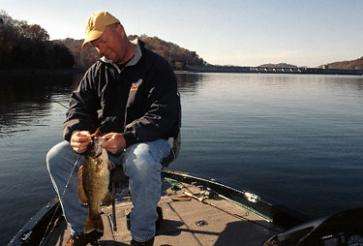
Last week I talked about why night fishing is so good for smallmouth bass, especially in the deep, clear waters that most of us fish. This week I want to talk night fishing basics.
The first thing you should know about night fishing is that the spots that hold fish during the day are also going to hold them at night. The difference is that the bass are usually shallower and more aggressive at night. That means instead of finding them at 30 feet, you might find them at 20 feet. And instead of crawling a jig to catch just a couple, you might be able to swim a jig or use a deep crankbait to catch a lot more.
A lot of night fishermen are fanatics about the moon phases after dark, and I’m a little like that, too. It’s one of the reasons that the moon is part of my Punisher Lures logo. I’m a big believer in moon phases, but I’m practical about it.
My basic rule about the moon and night fishing is that night fishing gets a little better when there’s a full moon. I think the fish understand that when they can see pretty well after dark, they don’t need to do so much feeding during the day.
During the new moon, when it’s pitch black outside, I think the bass will feed more during the day, knowing that conditions aren’t that good for feeding after dark.
Now I’m going to tell you something that probably sounds pretty strange. Get ready!
At night, I like to fish in the shade.
That’s right. Smallmouth are predators that like to ambush things. The best way for them to do that is to lie in dark places and look out into the light. They can see their prey better that way; it gives off a better silhouette. If they stay in the dark and keep their targets in the lighter areas, they can see the food, but the food can’t see them. Make sense?
OK, so now you know my biggest secret about night fishing — fish the shade. You can really have a lot of fun with this at your buddy’s expense. The next time you go out night fishing, keep your casts on the shady side of things and let him waste a lot of effort in the brighter areas. I bet you’ll beat him good!
Last week I mentioned that it’s important to keep your gear to a bare minimum at night. You don’t want a lot of unnecessary junk cluttering up your boat and tripping you after dark. I like to have three rods rigged and ready to go for most of my nighttime smallmouth fishing on Dale Hollow. These rigs will work for you, too.
The first is a 6-foot, 8-inch medium-heavy spinning rod (my favorite is the GLoomis BSR803) spooled with 10-pound-test fluorescent monofilament. On this rod I rig a 1/4- or 3/8-ounce Punisher jig in olive or camouflage with a Punisher Chunk trailer in red or green pumpkin avocado.
My second rod is a 6-foot, 9-inch medium-heavy baitcaster (I like the GLoomis SBR813) spooled with 15-pound-test Stren Microfuse line. This rod casts a 1/2- or 3/4-ounce Punisher spinnerbait in green pumpkin red with a single No. 6 red blade.
The last rod I plan to carry is another spinning rod — just like the first — with a Gene Larew 4-inch Salty Craw in pumpkin pepper or green/orange. I rig it Texas-style with a 1/4- to 3/8-ounce sinker and a 4/0 Gamakatsu EWG hook.
Are you wondering why I use monofilament and not fluorocarbon like just about everyone else these days? It’s simple. Fluorocarbon doesn’t light up under a black light and fluorescent mono does. I see a lot more nighttime strikes than I feel, and the mono really helps with that.
Until next time, if you have any questions or comments, I’d love to hear from you. Please e-mail me atStephen@thesmallmouthguru.com.





